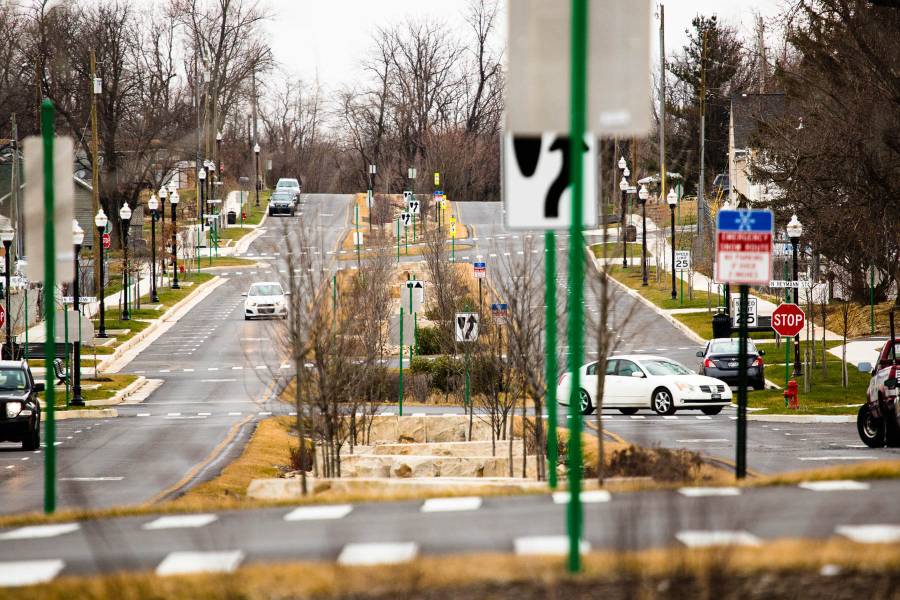A new form of funding helps cities finance green
Baltimore becomes the first city in Maryland to finance through environmental impact bonds

Flooding is not an unfamiliar scenario to those living along the coast, but an address near the ocean is no longer a requirement to be at risk; flood damage is quickly becoming a problem for many across the Chesapeake region. Every day, 51 billion gallons of water flow into the Chesapeake Bay from five major rivers—the Susquehanna, James, Potomac, Rappahannock and York—and the tributaries that feed them. As the amount of rainfall has risen and the intensity of storms has increased, these waterways have become growing flood sources.
A town 120 miles from the ocean and more than a dozen miles from the Chesapeake Bay, Ellicott City, Md., experienced a flood in 2016 that caused tens of millions in damage and killed two people. Most populated areas in the region share at least some of the same vulnerabilities of Ellicott City, including a lack of green spaces to help control stormwater runoff. Where there are green spaces, rain has a chance to soak down into the earth where it lands, becoming part of the groundwater and taking a longer journey through plant and soil filters before it reaches a body of water.
Though designing development and infrastructure to manage stormwater runoff is now a necessity, many of our towns were built before that was taken into consideration. As a result, an overabundance of impervious surfaces (buildings, pipelines, pavement, curbs and gutters) concentrate the stormwater and send it raging into our streams and rivers in quantities large enough to cause massive destruction.
Infrastructure is expensive, and changing how state and local governments manage their stormwater can be a risky undertaking. A new form of financing, the environmental impact bond (EIB), spreads the risk between private investors and local governments, thereby enticing more communities to try green infrastructure in an effort to make their districts more resilient to weather impacts.
How does it work?
EIBs are a form of “pay for success” financing. In these impact bonds, some of the risk shifts from the public sector (the government) to the private sector (a private investor). An impartial facilitator helps the public and private partners agree on measurements of success, and the private investor pays the initial costs for a project.
“Pay for success” programming began in the social sector in the form of a social impact bond (SIB), first implemented in Great Britain to lower juvenile recidivism. There have been dozens of successful SIBs, but pay for success is just beginning for the environmental realm. The first EIB occurred in October of 2016 to combat the District of Columbia’s combined sewer overflows, with the Calvert Foundation and Goldman Sachs Urban Investment Group providing the upfront capitol to DC Water.
Implementation can differ, but the general model is based on improvement to the environment. If a project meets its intended targets, the government pays back the private investor, possibly including interest. If a project does not meet the measurement of success, the public sector is not left holding the bill.
If the program is more successful than presumed, the government repays the private investor along with an increased interest rate or a “bonus” value. That slightly higher cost is repaid by the multiple benefits the community gains through successful green infrastructure: reduced flood risk, improved climate resiliency, a more beautiful town and even new jobs in the community.
A new EIB project totaling $10 million in green infrastructure is coming to the port city of Baltimore, the Chesapeake Bay Foundation (CBF) announced in a press release. Four million dollars in funding will come from state funds and the collection of city stormwater fees. The introduction of EIBs will allow Baltimore’s Department of Public Works to take a bigger bite into green infrastructure. A further six million dollars' worth of infrastructure projects will be funded through EIBs, with Kresge Foundation and other funders yet to be named acting as the private investors. CBF and its partner, impact investment advisor Quantified Ventures (QV), are helping the city to design the plan.
EIBs offer a new way for companies and communities to work together in tackling stormwater and continued infrastructure. “I’m proud that [Baltimore City Department of Public Works] is at the forefront of a creative, results-oriented approach to funding projects that improve the health and beauty of our communities,” said Baltimore Mayor Catherine Pugh. “We need to explore new ways of paying for investment in our cities.”

Comments
There are no comments.
Thank you!
Your comment has been received. Before it can be published, the comment will be reviewed by our team to ensure it adheres with our rules of engagement.
Back to recent stories